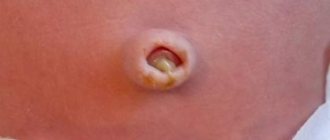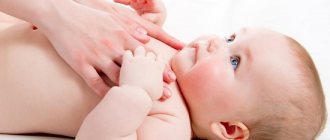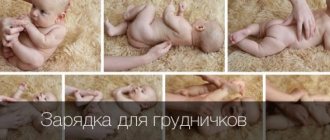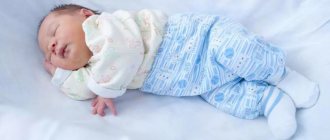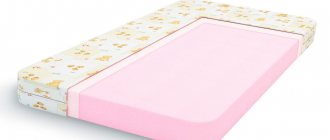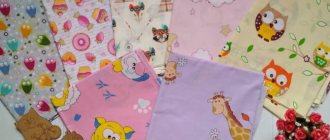The long-awaited moment has arrived. You and your baby are finally being discharged from the maternity hospital. While you were in the maternity hospital, the department staff helped you in caring for your child, and everything seemed clear and understandable. But when you are left at home, alone with your baby, everything seems much more difficult. So that you don’t get confused, let’s talk about newborn hygiene once again.
How to care for the umbilical wound
Why and why? The umbilical cord usually falls off on days 3-5 of the child's life. In its place remains the so-called “umbilical wound”, which heals by 10-14 days of life. In order to speed up the healing process and prevent infection from entering the wound, it is necessary to care for it daily. It is more convenient to treat the umbilical wound after bathing the child. It's not difficult at all, you can do it!
So, you will need: sterile cotton swabs, 3% hydrogen peroxide solution, salicylic alcohol.
- First you need to: remove rings and watches from your hands, wash your hands thoroughly.
- Unwaddle the baby, wash him if necessary and place him on the changing table.
- Using the thumb and forefinger of your left hand, spread the edges of the umbilical ring (with your index finger, pull the skin above the navel up towards the chest, and with your thumb, pull the skin under the navel down).
- Now take a bottle of peroxide in your right hand and drop 1-2 drops directly onto the umbilical wound. Wait 20-30 seconds until the peroxide fizzes and foams - it washes away the dead crusts, cleaning the wound. Continuing to hold the skin in the navel area with your left hand, take a sterile cotton swab with your right hand and dry the umbilical wound with gentle blotting movements. There is no need to try to remove those crusts that have not separated on their own - their time has not yet come. Perhaps they will disappear tomorrow or in a day.
- Take another cotton swab, dip it in salicylic alcohol, and spread the edges of the umbilical ring again. Gently but thoroughly blot the umbilical wound with the stick, and then wipe the skin around the navel in a circular motion.
- Let the alcohol dry for a few seconds
- That's all. You can put a diaper on your baby and swaddle him.
Giving a hygienic bath to an infant
- maintaining body hygiene;
- ensuring the child’s universal need to “be clean”;
- developing cleanliness skills;
- hardening the child.
Indications:
- proper hygienic care of a child's skin.
Contraindications:
- increased body temperature;
- child's illness;
- violation of the integrity of the skin.
Equipment:
- Bath for bathing;
- Bath diaper;
- Water jug;
- Water thermometer;
- Terry or flannel mitten;
- Baby soap or bottle with 5% solution of potassium permanganate;
- Large terry towel;
- A clean changing kit or clothes placed on the changing table;
- Sterile vegetable oil or baby powder;
- Latex gloves;
- Disinfectant solution, rags;
- Bag for dirty laundry.
Required conditions:
- The first hygienic bath should be carried out after the umbilical wound has healed;
- Do not bathe immediately after feeding;
- When swimming, ensure the room temperature is 22-24 C;
- Determine the temperature of the water for swimming only using a thermometer (it is not allowed to determine the water temperature by immersing your elbow in the water).
Performing the procedure:
- Explain to the mother the purpose and progress of the procedure;
- Prepare the necessary equipment;
- Place the bath in a stable position;
- Wash and dry your hands, put on gloves;
- Treat the inner surface of the bath with a disinfectant solution;
- Wash the bath with a brush, rinse with boiling water;
- Wipe the changing table with a disinfectant solution and place a diaper on it; Remove gloves, wash and dry hands.
- Place a folded diaper on the bottom of the bath in several layers (the edges of the diaper should not touch the side walls of the bath);
- Place a water thermometer in the bath;
- Fill the bath with water to ½ or 1/3 T 36-37 C.
Note:
a) when filling the bath with water, alternate cold and hot water;
b) control the water temperature only using a thermometer;
11. Fill a jug with water from the bath to rinse the child;
12. Undress the child (if necessary, wash under running water);
13. Throw clothes into dirty laundry bags;
14. Take the child in your arms, supporting the back and back of the head, right buttock and thighs with one hand;
15. Slowly immerse the baby in the water (first the legs and buttocks, then the upper half of the body). The water should reach the baby's nipple line, leaving the upper part of the breast open;
16. Release your right hand, continuing to support the child’s head and upper half of the body with your left;
17. Put a “mitten” on your free hand (if necessary, soap it with baby soap) and wash the child in the following sequence: head (from the forehead to the back of the head) neck torso limbs (rinse the natural folds of the skin especially thoroughly). Lastly, wash the genitals and intergluteal area;
18. Turn the child face down;
19. Rinse the baby with water from a jug (the water has cooled to 35-36 C);
Note: It is advisable to have an assistant.
20. Throwing a towel on, place the baby on the changing table;
21. Dry the skin with blotting movements.
Completing the procedure:
- Treat the natural folds of the skin with sterile vegetable oil or baby powder;
- Dress the baby and put him to bed;
- Place the diaper from the changing table and the “mitten” in a bag for dirty laundry (the mitten must be attached);
- Drain the water from the bath and rinse it;
- Wear gloves;
- Treat the inner surface of the bathtub and the working surface of the changing table with a disinfectant solution;
- Remove gloves, wash and dry hands.
Umbilical toilet
- prevent infection of the umbilical wound;
- contribute to the reduction of the umbilical wound and its scarring.
Indications:
- ensuring proper daily care of the newborn;
- loss of the umbilical cord;
- the presence of a non-epithelialized umbilical wound.
Contraindications: no
Equipment:
1. sterile cotton swabs;
2. tray for waste material;
3. 3% hydrogen peroxide solution;
4. 70% ethyl alcohol;
- brilliant green solution;
- sterile pipette;
- changing kit prepared on the changing table;
- latex gloves;
- container with disinfectant solution, rags.
Required conditions:
When treating the umbilical wound, be sure to stretch its edges (even if a crust has formed).
Safety precautions: Do not leave your baby unattended on the changing table.
Possible problems: child anxiety, bleeding of the wound, serous or purulent discharge, hyperemia of the skin around the wound.
| Preparation for manipulation | |
| 1.Explain to the mother the purpose and progress of the manipulation and obtain her consent | Mother's right to information |
| 2. Prepare the necessary equipment | Ensuring accuracy and speed of manipulation |
| 3.Wash and dry your hands, put on gloves. Treat the changing table with a disinfectant solution and lay a diaper on it. Remove gloves, wash and dry hands, treat hands with antiseptic | |
| 4.Place the baby on the changing table | The most comfortable position for the child |
| Performing a manipulation | |
| 1. Stretch the edges of the umbilical wound well with the index finger and thumb of your left hand. Note: if it is impossible to open the umbilical wound due to the presence of a dried crust, generously moisten the wound with a swab with a 3% solution of hydrogen peroxide or sterile vegetable oil and leave for a while (can be until the next swaddling.) | Ensuring maximum access to the umbilical wound |
| 2.Drop 1-2 drops of a 3% hydrogen peroxide solution from a pipette into the wound. Remove the “foam” that has formed in the wound with a sterile cotton swab, moving from inside to outside (throw the stick into the tray) | Achieving mechanical cleansing of the umbilical wound |
| 3.Keeping the edges of the umbilical wound stretched, treat it with a sterile cotton swab moistened with 70% ethyl alcohol, moving from inside to outside (drop the stick into the tray) | Providing a disinfecting and drying effect. Treatment with movements from the inside out or from the center to the periphery prevents infection from entering the umbilical wound |
| 4. Treat the skin around the wound with ethyl alcohol using a cotton swab, moving from the center to the periphery (drop the stick into the tray) | Preventing the spread of infection to surrounding tissues |
| 5. Treat (if necessary) the umbilical wound (without touching the skin around the wound) with a solution of brilliant green using a cotton swab (drop the stick into the tray) | Providing a disinfecting and drying effect. a “strong” solution of potassium permanganate can cause skin burns |
| Completion of manipulation | |
| 1.Place the baby in the crib on its side. Wash and dry your hands. | Ensuring the safety of the child |
| 2. Wear gloves. Remove the diaper from the changing table and place it in the laundry bag. Wipe the working surface of the changing table with a disinfectant solution. Remove gloves, wash and dry hands | Ensuring infection safety |
Feeding a baby
infopedia.su
How to wash a newborn baby
Why and why? The skin of babies is much more delicate than that of adults, irritation and diaper rash occur very easily, so you need to wash the baby every time after he has had a bowel movement. In addition, keeping the skin clean helps your baby develop the first skills of neatness.
If you are away from home, you can use special baby wipes instead of washing, but you should not completely replace washing with such a simplified skin treatment.
A little trick. Babies tend to have a bowel movement after or during each feeding. This leads to the conclusion that washing before eating is a thankless task.
- The first thing you need to do is roll up your sleeves, remove rings and watches from your hands, adjust the temperature and pressure of running water. Prepare a thin diaper to dry the skin after washing. It is very convenient to just hang it on your shoulder and always have it at hand.
- Unwaddle your baby and remove his diaper.
- It is more comfortable to hold the baby with your left hand and wash it with your right.
- The boy is held face down when washing. Take the baby so that his chest lies across your forearm, while you hold his shoulder with the fingers of your left hand. Oddly enough, but hanging in this position, the baby does not experience the slightest discomfort.
- The girl needs to be washed only from front to back, so as not to contaminate her genitals. Place the child's back on the forearm of your hand, so that the head is on the bend of the elbow, and you will hold her left thigh with your fingers. This position allows you to securely hold the baby, and leaves you complete “freedom of action.”
- Wash your baby by scooping water into your palm using gentle movements from top to bottom, carefully removing dirt from the skin. It is especially important to wash all skin folds where dirt can accumulate and cause irritation. Do not use soap unless absolutely necessary; washing with soap once a week is sufficient.
- When washing the girl, there is no need to “rub” the genitals, since the mucous membrane is very delicate. In addition, overzealous washing removes the protective lubricant that protects the genitals from pathogens.
- After washing, dry your baby's skin. First, wrap the diaper over your baby's lower body and transfer him to the changing table. Then thoroughly blot the genitals, groin, buttocks and popliteal folds.
- If necessary (irritation), treat skin folds with a small amount of baby oil.
- Your baby is happy with life again. Now it would be good to “air out the butt” for 5-10 minutes before putting on a new diaper.
Mom and children
Newborn Caring for a newborn Bathing a newborn, hygienic baths for a child
Bathing a newborn, hygienic baths for a child
newborn – Newborn care
The first bath of a newborn baby in a bath should be carried out after the remainder of the umbilical cord falls off and the umbilical wound has healed. Typically, this occurs in the 2nd week of life. To bathe a child you will need: a bathtub (preferably enamel, but plastic is also possible), baby soap, a soft sponge, a water thermometer, a jug or other container with warm water for rinsing the child, a diaper and a towel. Frequency of bathing children: · during the first 6 - three months - daily; from 6 months to 1.5 years - every other day; up to 3 years - 2 times a week; over 3 years - at least 1 time a week. Water temperature in bathroom: · during the first month of life - 37.5-37 degrees C. At the same time, the newborn is bathed in boiled water, which is cooled to the desired temperature. · up to 6 months - 36.5-37 C; · from 6 months. up to 12 months 36.0-36.5 C ; Duration of taking a bath: · up to 12 months - 5-10 minutes · from 12 months to 2 years - 8-10 minutes · after 2 years - 10-15 minutes The duration of the bath is increased gradually , start from a few minutes and increase the time with each subsequent dose. Step by step procedure: 1. Before bathing, wash the bath thoroughly with soap and a brush, then rinse with hot water;2. The position of the child in the bath. The head and upper body are supported with one hand, and the buttocks and thighs are secured with the other hand. Supporting the child's legs, he is carefully placed in the water. This position ensures the greatest relaxation of the child's muscles. You can also use a special stand for swimming. Up to 6 months, the baby’s position in the bath is lying down. So that the head is slightly higher than the body (water should not get into the external auditory canals). To do this, you need to hold the baby's head in your hand. The water should be at the level of the baby's nipples, leaving the upper part of the chest open. After 6 months - children can sit in the bath, freely, without tension, immersed to the level of the nipples.3. So, with one hand they support the child’s head and back, with the other they soap the neck, torso, and buttocks. Pay special attention to the folds in the neck, elbows, groin area, behind the ears, under the knees and between the buttocks; 4. Then the child is lifted above the water, turned back up and doused with clean water from a separate bowl; 5. Wrap the baby in a warm diaper and dry the baby’s skin with light blotting movements;6. Next, the skin folds are treated (lubricated) with sterile petroleum jelly or other baby care products; 7. Swaddle (or dress) the baby and put him in the crib. It should be remembered that: · the bath is carried out at certain, preferably the same, hours. Not earlier than an hour after feeding or 40-45 minutes before it, as well as 1-1.5 hours before bedtime; · after a bath, the child needs to rest for 20-30 minutes; · soap is not used more often when bathing a newborn 2 times a week. Possible problems: 1. For some children, daily bathing can cause skin irritation (especially if the water is hard). Recommendations: bathe the child with the addition of starch - dilute 100-150 grams of starch with warm water and pour the resulting suspension into the bathtub;2 . sometimes after frequent washing with soap, the hair becomes dry. Recommendations: lubricate the hair with vegetable oil after bathing. After oil treatment, wipe the hair dry with a cotton swab; 3. If elements of prickly heat appear on the baby’s skin. Recommendations: add an infusion of string or chamomile to the bath. To prepare the infusion, take 1 tablespoon of the herb per glass of water (200 ml) and leave for 10 minutes. You need to login or register to post comments. Discuss in the forum. ()
mamaideti.com
Bathing a newborn
Why and why? Bathing a newborn (hygienic bath) is carried out for all healthy children after the umbilical remnant falls off. Before the umbilical wound heals, it is recommended to bathe the baby in boiled water or running water, but you need to add a solution of potassium permanganate (potassium permanganate) to it.
Until your baby is six months old, it is advisable to bathe him daily; in the second half of his life, you can do this every other day. As a rule, children really like to swim, because before birth, water was their natural element. In water, the muscles relax, the child feels comfortable and calm. The duration of bathing in the first year of life is 5-10 minutes. Washing with soap is carried out no more than once a week. It is advisable to bathe the child no earlier than an hour after feeding, preferably 10-15 minutes before evening feeding.
It is more convenient to bathe a newborn baby together; most often, the father is called upon to help, and in many families, bathing the baby is exclusively the father’s “honorable mission.” Large and reliable male hands hold the baby’s tiny body with amazing tenderness, which contributes to the emergence and development of close contact between the child and the father, who at these moments feels very needed. But if you have to do without an assistant, don’t worry, you can do it just fine on your own.
Important! If your baby is unwell, has a fever or signs of skin irritation, it is better to postpone bathing until you consult your pediatrician.
You will need: a baby bath, a jug of warm water for rinsing the baby, a special water thermometer, baby soap, a terry mitten, a large terry towel, a diaper, baby oil, a changing table with prepared clothes for the baby, cotton swabs with limiters or cotton swabs.
If the umbilical wound has not yet healed, prepare two containers with cold and hot boiled water or a solution of potassium permanganate to add to running water. The solution of potassium permanganate must be added to the water “drop by drop” until the water turns a faint pink color. Before using potassium permanganate, make sure that the crystals are completely dissolved, as getting a potassium permanganate crystal on the skin can cause a burn.
The air temperature in the room while bathing the child should be 22-24 degrees. You can bathe your baby in the bathroom, if it is spacious enough, or in the kitchen.
- First of all, you need to prepare the bath - wash with a brush and soap and rinse with boiling water. Place the bath in a stable, comfortable position and fill it ½ full with water. First pour cold and then hot water to avoid steam formation. Now you need to immerse the thermometer in water. The temperature of the water in the bath should be 37-37.5 degrees. Measuring the water temperature with your elbow is only possible if you have sufficient experience; a thermometer is always more reliable.
- Lay out the baby's clothes on the changing table, lay a towel on top, and place a diaper on it for wiping. However, you can put the diaper near the bath to make it more convenient for you to take it.
- Undress the child and, if necessary, wash him. Take the baby so that the head rests on the forearm of your left hand, and hold the baby’s left shoulder joint with your fingers (the thumb clasps the shoulder from above, place the other fingers in the armpit). Use your right hand to support the baby's buttocks and legs.
- Slowly immerse the baby in the bath: first the buttocks, then the legs and torso. Continue to support the baby's head with your left hand, leaving your right hand free for washing. The water level should reach the baby's armpits.
- Swing the child on the water back and forth, left and right. Your movements should be smooth and unhurried. Smile at your baby and talk to him affectionately.
- If you plan to wash the child with soap, then the “mitten” is put on the right hand. Lather your body using gentle circular motions and immediately rinse the soaped areas. First, wash your head from the forehead to the back of the head, then your neck, arms, chest, abdomen, legs. Rinse skin folds thoroughly. Lastly, wash your buttocks and genitals.
- Remove the baby from the water with its back facing up. Rinse your body and wash your baby's face with water from a jug. Place a diaper on the baby, place him on the changing table, and dry the skin with gentle blotting movements.
- Dry your ears with cotton swabs or cotton swabs.
- Lubricate the folds of the skin with baby oil. If necessary, treat the umbilical wound.
- Swaddle or dress your baby.
Now, to feel complete happiness, it would be nice for your baby to eat and sleep.
V. Algorithm for performing a simple medical service.
Preparation for the procedure:
Performing the procedure:
- Undress the child. Children in the first months of life can be immersed in water in a diaper, the immersion is carried out slowly, carefully, with one hand supporting the back and head of the child, and with the free hand in a mitten the scalp, neck, then the torso, front and back, and finally the arms are soaped and legs. Do not wash your face with bath water; boiled water is used for this. The child is held so that the water reaches his shoulders.
- After finishing bathing, the child is taken out of the water, held back up, doused with clean water from a jug (36 C), wrapped in a sheet, and dried with blotting movements.
- Treat skin folds with sterile balls containing sterile oil.
- Then the baby is swaddled (dressed).
End of the procedure:
- The diaper, sheet and mitten are removed for disinfection.
- Treat the inner surface of the bath with disinfectant. solution.
- Treat your hands hygienically and dry them.
- Make a record of the manipulation in the medical documentation.
Morning toilet of a newborn
Why and why? We all know that “cleanliness is the key to health,” so every day we wash ourselves, brush our teeth, take a shower or bath. Without these usual hygiene procedures, a person feels uncomfortable. For a newborn baby, daily skin care is much more important than for an adult; in addition, the first habits of cleanliness begin to form unconsciously at such an early age.
The baby's daily toilet consists of washing, treating the eyes, nose, and skin folds. Until the umbilical cancer heals, it also needs to be treated daily. You need to wash your child after a night's sleep and during the day every time the child has had a bowel movement. The ears are treated as necessary in case of contamination and dried after each bathing. Children's nails are trimmed as they grow.
You will need: cotton pads (cosmetic pads), cotton wool for making flagella, baby oil or Vaseline, a container with warm boiled vodka, a container for used materials, scissors with rounded ends, cotton swabs with limiters, a set for treating the umbilical wound.
- First you need to remove rings and watches from your hands and wash your hands. Prepare everything you need: open a bottle of oil,
- wash the water container with soap, scald with boiling water, fill with warm boiled water,
- twist nasal flagella from small pieces of cotton wool, about 3 cm long and 2-3 mm in diameter,
- prepare a kit for treating the umbilical wound.
Now that you have everything at your fingertips, let's get down to business!
hygienic bath for newborns algorithm
This page contains the most popular posts and comments from our users on the topic “Hygienic bath for a newborn.” This will help you quickly get an answer to your question, and you can also take part in the discussion.
Caring for a newborn How is the umbilical cord ligated and treated? The umbilical cord is tied in two stages 2-3 minutes after birth. At the first stage, with the cessation of pulsation of the umbilical cord, 2 sterile Kocher clamps are applied to it: one at a distance of 10 cm from the umbilical ring, the second 2 cm outward from the first clamp. The area of the umbilical cord between the clamps is treated with a 5% iodine solution,...
Here, girls, I found it here on Olga’s website from Rostov-on-Don! I think many people (like me, without experience, will be interested, and for mothers with experience, I will be very grateful if you add something of your own)) Caring for a newborn!!! How is the umbilical cord ligated and treated? The umbilical cord is tied in two stages 2-3 minutes after birth. At the first stage, with the cessation of pulsation of the umbilical cord, it...
How is the umbilical cord ligated and treated? The umbilical cord is tied in two stages 2-3 minutes after birth. At the first stage, with the cessation of pulsation of the umbilical cord, 2 sterile Kocher clamps are applied to it: one at a distance of 10 cm from the umbilical ring, the second 2 cm outward from the first clamp. The area of the umbilical cord between the clamps is treated with a 5% iodine solution, then cut...
oh my God, where did you find this fossil?!.. no one bathes in potassium permanganate, either in the RD (this has been prohibited for a long time) or at home, and even more so, they don’t treat wounds with it (the navel)... a gas outlet tube is also unnecessary, an enema too... pans for the nipples even more so... There is no need to boil water for bathing and do not pour anything into the bath so as not to dry out the child’s skin, do not wash it often with soap (no more than once a week in the first six months of life) and do not clog the child’s skin.
Source
In the article we will describe in detail what is included in the concept of “daily morning toileting of a newborn” and describe a detailed algorithm of actions when performing the primary toileting of a newborn.
What procedures are included in a newborn’s morning toilet?
Like an adult, an infant needs daily morning toileting. Its goal is not only hygiene, but also preventive measures to help avoid the appearance of skin pathologies in the baby. It is better to perform this procedure in the same morning hours, before feeding the baby.
Visual examination of the baby
It is necessary to examine an infant daily, after thoroughly washing your hands. The skin of a newborn is tender and vulnerable, so there is a high probability of any infections occurring in it.
An air bath is the best method for preventing diaper rash in a baby. In addition, this is a great way to harden it.
2. Completely undress the child, of course, at a comfortable room temperature. If you need to wash your butt, then do it.
3. Gently lift the baby’s arms and legs one at a time. Carefully examine the skin for rashes, diaper rash, and redness.
Body temperature measurement
You need to know that an infant has not developed a thermoregulation function, so the normal body temperature of an infant is from 36.5° to 37.5°.
Washing a newborn baby
• special baby oil. It is permissible to use sunflower oil or Vaseline oil, after steaming it in a water bath for 10 minutes.
Soak a cotton ball in warm boiled water and squeeze lightly. Gently wipe the child's face - forehead, cheeks, chin, mouth, nose. At the end of the procedure, blot your face with the prepared
Source
Normally, a hygienic bath is recommended for newborns after the umbilical cord has fallen off. Therefore, after discharge from the maternity hospital, if there are no contraindications and other doctor’s prescriptions, the baby can already be bathed.
A newborn should be bathed only in boiled water, because... his skin is very delicate, and simple tap water is hard, and also in order to avoid infections in the umbilical wound. If the umbilical wound has not yet healed and is not covered with skin, you can add a few crystals of potassium permanganate to the bathing water (so that the water is pale pink). Before using such a bath, you should consult with your pediatrician (he will give recommendations on the concentration of the solution that is suitable specifically for your baby).
It is necessary to ensure that there is no high humidity in the bathroom. The best option is dry and warm. If the air temperature in the bathroom is cool, it is better to warm the room with a heater rather than by running hot water for a long time, since humidity negatively affects the child’s respiratory system. Otherwise, you can bathe in the room.
Place the child on your arm so that his head is on the bend of the elbow, and you can grab his leg under the knee with your hand.
After each bath, the mitten must be boiled! The child should be bathed in boiled water at least until the umbilical wound heals.
During bath time, talk gently to your baby to calm him down. Bathing should be carried out by two people according to the principle - one holds the child, the other waters. If your baby cries during the first baths, be patient and gentle; this is not a reason to refuse bathing. Over time, the child will get used to it, will feel free, and the bath will become a pleasure not only for him, but also for you.
Swimming is better
Source
Technique for giving a hygienic bath to newborns and infants
The first hygienic bath for a newborn baby is performed after the umbilical cord falls off and the umbilical wound heals. During the first 2-3 months of a child’s life, they bathe them in boiled water. A solution of potassium permanganate is added to the bath until it turns light pink. It is pre-filtered so that undissolved crystals do not cause skin burns. It is recommended to carry out a hygienic bath with potassium permanganate for one to two weeks. Longer use causes dry skin.
In the first half of life, hygienic baths are performed daily, in the second - every other day, at an older age - 2 times a week. In the hospital
Children are bathed once every 7 days, more often if indicated. A note about the hygienic bath is made in the medical record of the inpatient (registration form No. 003/u, see Appendix 1). On the day of bathing, bed linen is changed.
37.5-38°C. When rinsing a child, use water at a temperature 1°C lower. The duration of the bath for children in the first year of life is no more than 5-7 minutes, in the second year - 8-10 minutes, for children over 2 years old - 10-15 minutes. Once or twice a week, young children are bathed with soap (“Children’s”, “Lanolin”, “Egg”), and for older children it is used once a week.
It is advisable to carry out hygienic baths at certain hours, no earlier than 1 hour after feeding or 10-15 minutes before it, 1-1.5 hours before bedtime. Bathing your baby immediately after eating is not recommended due to possible regurgitation or vomiting. Late evening time for swimming is undesirable due to its stimulating effect.
During bathing, precautions must be taken: do not leave the child alone in the bath or on the changing table to avoid the risk of aspiration of water or falling. Please note
Source
The umbilical cord is tied in two stages 2-3 minutes after birth. At the first stage, with the cessation of pulsation of the umbilical cord, 2 sterile Kocher clamps are applied to it: one at a distance of 10 cm from the umbilical ring, the second 2 cm outward from the first clamp. The area of the umbilical cord between the clamps is treated with a 5% iodine solution, then cut with sterile scissors. After this, the newborn is wrapped in sterile diapers and transferred to a heated changing table, and if necessary, a hygienic bath is given.
The second stage should be preceded by re-processing the midwife's hands. The remainder of the umbilical cord is wiped with a sterile napkin, squeezed tightly between the thumb and forefinger, and Rogovin staples are applied between the Kocher jaws or the umbilical cord is tied with a silk ligature at a distance of 1 cm from the umbilical ring. The remainder of the umbilical cord is cut off with sterile scissors, and the cut surface is treated with a 10% solution of potassium permanganate.
For faster mummification and faster falling off of the umbilical cord, the ligation can be repeated 12-24 hours after birth, subject to all aseptic rules. A bandage is not applied to the umbilical cord remnant (method of open management of the umbilical cord remnant according to M. L. Vydrin), but in this case it is necessary to strictly observe the rules of asepsis and use sterile diapers.
In case of Rh or ABO incompatibility between the blood of the mother and the fetus, the umbilical cord is clamped immediately after the birth of the child. The umbilical cord is tied at a distance of 5-10 cm from the umbilical ring (if a replacement blood transfusion is necessary through the umbilical cord vessels).
if the navel of a newborn bleeds The umbilical cord is the intrauterine connection between the baby and mother. After birth, this connection is interrupted, since the baby’s organs can function independently.
After this, the baby will have a normal one, as we are used to.
It is performed by a midwife after ligation of the umbilical cord. A sterile gauze pad soaked in sterile vegetable oil partially removes the cheese-like lubricant in the folds. It is not advisable to completely remove vernix, as it protects the skin from irritation.
Source
Changing the dates of the Competition is possible only due to unfavorable weather conditions and upon agreement of these changes with the Ministry... completely>>
The purpose of the conference: to study the life and work of an outstanding naval commander, scientist and navigator, admiral of the Russian Fleet, who made a huge contribution... completely>>
Re-issuance of licenses. According to paragraph 4 of Article 35 of the Law, the licensee is obliged to submit an application for re-issuance of a license within thirty days from the date of reorganization... in full>>
The purpose of mastering the discipline “Research Methods in Management” is to implement the requirements of the qualification characteristics, the basic requirements for pr… completely>>
Collection of algorithms for nursing activities in the discipline “Nursing in Pediatrics.” Textbook for students of medical colleges and technical schools / N.V. Fukalova, N.V. Lisikhina –
THIS COLLECTION CONTAINS INFORMATION ABOUT THE MOST COMMON MANIPULATIONS IN THE WORK OF PEDIATRIC NURSES. RECOMMENDED FOR STUDENTS OF MEDICAL COLLEGES STUDYING IN THE SPECIALTY "NURSING", AND CAN ALSO BE USED FOR PREPARING MEDICAL UNIVERSITY STUDENTS TO OBTAIN ADMISSION TO PERSONS WHO HAVE NOT COMPLETED THE MASTER OF BASIC EDUCATION CALLING PROGRAMS OF HIGHER MEDICAL EDUCATION, AS WELL AS PERSONS WITH HIGHER MEDICAL EDUCATION TO CARRY OUT MEDICAL ACTIVITIES IN THE POSITIONS OF NURSING MEDICAL STAFF IN MEDICAL ORGANIZATIONS
a newborn sniffles while sleeping Quite often in the first months of the baby’s life, the mother notices that the baby’s nose is stuffy. The baby's breathing becomes noisy, and there is something sniffling and "squishing" in his small nose, and the mother begins to worry whether her mother is
In modern conditions, one of the priorities of state policy is to preserve and strengthen the health of the population. The implementation of the national project “Health” provides for the provision of high-quality medical care to the population of the Russian Federation, which cannot be achieved without the presence of competent, highly qualified mid-level medical workers, whose training is carried out by medical
Source purchase
n1.docx
Place a measuring tape on your head following the guidelines: behind - the occipital protuberance, in front - the brow ridges, remember the result
Place a measuring tape on the back of the chest - the lower corners of the shoulder blades, in front - the lower edge of the isola, remember the result
Sterile petroleum jelly, sterile gauze pads, sterile tray, sterile diaper, sterile gloves, waste tray, container with disinfectant for gloves.
Wipe the natural folds of the newborn in the following order: behind the ear, cervical, axillary, elbow, wrist.
Sterile cotton swabs, 1% alcohol solution of brilliant green, 3% solution of hydrogen peroxide; container for waste material
Explain the procedure to the mother and obtain consent.
Place the child on a table covered with a sterile diaper, unwrap the child
Performing the manipulation:
Moisten a cotton swab with 3% hydrogen peroxide solution
Treat the umbilical wound with a sterile swab and cotton wool soaked in a 1% alcohol solution of brilliant green in a circular motion from the center to the periphery
Preparation for manipulation:
2.Preparation for manipulation:
Cover the horizontal stadiometer with a clean diaper so that
Preparation for manipulation:
Preparation for manipulation:
Preparation for manipulation:
- Determine the temperature of the bathing water only using a thermometer (it is not allowed to determine the water temperature by immersing your elbow in the water)
Preparation for manipulation:
Preparation for manipulation:
12. ANTENATUAL PARTONAGE
The first prenatal care must be carried out no later than 7 days from the moment the pregnant woman is registered
Source
obditi.ru
Washing and eye care
Washing a newborn baby is done with warm boiled water using cotton pads. Children over 3 months can be washed with running water.
Take a cotton pad, moisten it with water, squeeze lightly (so as not to drip). Wipe your baby's face in the following order: forehead, cheeks and, lastly, the area around the mouth. Discard this disc.
Then treat your eyes with separate cotton pads for each eye, moistened with warm boiled water, from the outer corner of the eye to the inner.
Take a dry cotton pad and dry your child's face in the same sequence.
Care for skin folds
To treat skin folds, use baby or Vaseline oil. Ready-made baby wipes impregnated with oil are quite convenient. You can moisten a cotton pad with oil, or you can simply apply it to your palms.
Important! You cannot use oil and powder at the same time, because in this case the powder will roll into lumps, which can cause skin irritation and diaper rash.
First, lubricate the folds of the upper half of the body (from top to bottom) - behind the ears, cervical, axillary, elbow, wrist. Then, with another tampon, fold the lower half of the body (from bottom to top) - ankle, popliteal, inguinal, buttock.
Now, so that the baby does not look like an oil donut, excess oil from the skin needs to be removed with a dry cotton pad.
Ear care
The ears and external auditory canals should be dried from water after bathing. It is very convenient to use ready-made “ear” cotton swabs with limiters. If you don’t have them, you can make small tampons out of cotton wool. Dry your baby's ears with gentle blotting movements using separate swabs.
If discharge (earwax) has accumulated in the external auditory canal, you need to clean it using cotton swabs with limiters or cotton swabs soaked in Vaseline or baby oil. Insert the flagellum into the external auditory canal with careful rotational movements to a depth of no more than 0.5 cm. Use a separate flagellum for each ear canal.
Trimming nails
A newborn baby's nails need to be trimmed as they grow on his hands and feet to prevent the baby from scratching himself. Special children's scissors with rounded ends are convenient and safe.
A little trick. Many mothers are afraid of the thought that they will have to cut the nails on such tiny fingers that are constantly in motion. Therefore, everyone will be calmer if they do this “delicate work” when the baby is sleeping.
Take the child's hand so that only one finger remains free, on which you are going to trim the nail. Grab the finger with the thumb and index fingers of your left hand, holding it on both sides, and with the remaining fingers of your left hand you can hold the child’s other fingers.
Fingernails are trimmed in a semicircle, and toenails are trimmed in a straight line to avoid future problems such as ingrown toenails. You need to trim your nails with continuous movements of the scissors, and not “piece by piece.” Please check if there are any protruding sharp parts left on the nails.
Don’t forget to carefully collect the trimmed nails so that if they get lost in the folds of clothes and linen, they won’t injure your baby’s skin.
